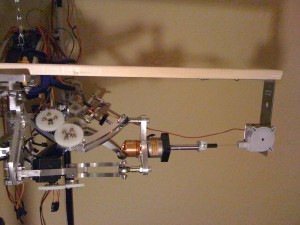My recent talk at TEDxConcordia is now online:
3D Printer SDM
Another project that I started recently aims to increase the material efficiency, versatility, and accessibility of SDM (Shape Deposition Manufacturing) using a 3D printer. Conventionally, SDM is performed with coarse material deposition followed by a milling operation for each material layer or using high precision casting and an abundance of sacrificial materials. Multimaterial 3D printers exist already (such as the Objet Connex Series) but they are prohibitively expensive, and are not designed to accommodate embedded actuators or sensors.
This project is based on work done by the Fab@home project out of Cornell  University as their printer is already multi-material ready. The downside is that the stock printer deposits material using small syringes which severely constrains the build size without multiple refills. A dual ABS/PLA and EVA extruder has been designed to provide the continuous performance necessary to investigate shape deposition manufacturing.
The printer can be seen here in a well ventilated section of my room(!):
The ABS extruder is working very well, but the EVA extruder needs a redesign as the extrusion material melts way before it even reaches the nozzle because of inadequate thermal insulation. A sample part was printed in ABS and then manually filled in with EVA to test cohesion and material property based joint emulation.
Posted in Uncategorized.
rev="post-73" No comments
System Identification
In order to develop a proper controller for the vehicle, it is important to understand its response. Since I have the luxury of a functioning prototype, the system’s response can be determined experimentally. Using a string potentiometer, it was possible to determine the suspension arm’s expansion over time when given a step input, sampling every 1ms. The experimental setup can be seen here:
The system’s response can be seen here:
Since it is highly linear for most of the motion (and the slope corresponds to 94% of the servo’s maximum no load velocity) this response is very close to ideal.
Posted in Uncategorized.
rev="post-64" No comments
Concordia Journal Interview
I was asked to do an interview for the Concordia Journal to talk about my Telescoping Active Suspension Arm Vehicle. The article and accompanying video interview can be found here. The author, Russ Cooper, did a great job simplifying and explaining the differences in various suspension system approaches.
Posted in Uncategorized.
rev="post-62" 1 comment
Telescoping Demonstration
This is a demonstration of the telescoping mechanism working in all four wheels. The telescoping suspension arms are increasing the vehicle’s width proportionally to the wheel’s velocity. The vehicle’s steering is acheived by the arms’ telescoping mechanism. In the future, the vehicle’s width will be proportional to its centrifugal acceleration, that is to say v^2/r.
Posted in Uncategorized.
rev="post-58" No comments
Kinematic Simulation with SimMechanics
Since the kinematic analysis of a 3RRS mechanism, as used in this telescoping active suspension vehicle, had been previously done I decided to obtain the specific kinematics of my mechanism as a stepping stone towards creating a high fidelity model of the full vehicle. This was done by using Simulink’s SimMechanics toolbox since the specific link geometry can be imported directly from CAD. Actuator and sensor blocks can then be used to create a lookup table of the inverse kinematics, which are necessary for the proper control of the vehicle. The keen observer will notice that this is a somewhat simplified arm where analytically redundant links and pieces were removed. The full block diagram can be seen here:
Posted in Uncategorized.
rev="post-52" 1 comment
ADAMS Simulation
Since the most important work to be done on the vehicle at this point is the inverse kinematics of the 3-RRS mechanism, I learnt how to use MSC Adams to model the vehicle and move the end effector along a given trajectory. The angles between the links can then be monitored and output as a high resolution lookup table. In this simulation, the distance of the end effector (red) increases linearly while the pivot around the X and Y axis are moving at 10Hz and 100Hz respectively. Because significant user input was required to iterate throughout the arm’s entire range of motion, this was not the ideal solution.
Posted in Uncategorized.
rev="post-49" No comments
New Ring
The ring mentioned in a previous post unfortunately fell apart long ago… I’ve been thinking about remaking something similar for a while and have gone through many different designs, finally settling on this one long enough to actually contemplate machining the thing!
The ring body:
Holding this movement:
Posted in Uncategorized.
rev="post-46" No comments
Conference Presentation and New Simulation
This is a simulation to show the mechanism’s ability to maintain the wheel’s perpendicularity to the ground all throughout the arm’s travel. I just wanted to show it since this motion is not possible in the real vehicle yet… Also, I presented at the AIM 2010 IEEE/ASME Mechatronics conference last Friday, the presentation (with notes) can be found here.
Posted in Uncategorized.
rev="post-44" 3 comments
Front Half Video
This is a video demonstrating manual control of the vehicle’s front two suspension arms as they are extended and pivoted. This does not yet incorporate the vertical pivoting in the mechanism that will be used to maintain the wheels’ perpendicularity to the ground through the full range of motion.
Posted in Uncategorized.
rev="post-41" No comments






